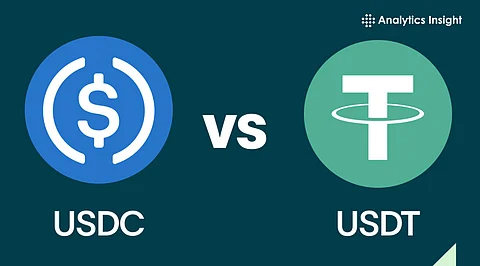

USDT leads the stablecoin market with over 64% share and unmatched global liquidity.
USDC is rapidly growing among institutions due to its transparency and regulatory compliance.
Together, these two stablecoins control nearly 90% of the total stablecoin market.
Stablecoins have become the backbone of the digital asset economy. They offer a bridge between volatile cryptocurrencies and the steadiness of fiat currency. In 2025, the competition between Tether (USDT) and USD Coin (USDC) is at the forefront. Both tokens are competing for dominance in a rapidly evolving crypto market. So, let’s dig deeper into which stablecoin is leading, and why.
USDT remains the undisputed leader in the stablecoin sector. As of February 2025, USDT boasted a market capitalization of $146 billion. Thus, commanding about 64% of the stablecoin market share. In contrast, USDC’s market cap stood at $56 billion, representing a 24.5% share. Together, these two stablecoins control nearly 90% of the total stablecoin market.
On Ethereum, the largest blockchain for stablecoins, USDT still leads with a 52% share. However, USDC is catching up, having increased its share to 30% in 2025. While USDT’s dominance is clear, USDC’s growth trajectory is notable. The latter’s market cap surged by $16 billion in 2025 alone, outpacing USDT’s $7 billion increase over the same period.
USDT’s longer history (launched in 2014) has cemented its position as the most widely adopted stablecoin globally. It is integrated into virtually every major exchange and DeFi platform, making it the default choice for traders seeking liquidity and minimal slippage. Its vast liquidity pools allow for large transactions with ease, making USDT particularly attractive for high-frequency traders and institutions operating at a larger scale.
USDC, while newer (launched in 2018), has seen rapid adoption, especially among institutional users and within the United States. Its transaction volume rivals USDT’s. Due to its regulatory clarity and transparency, USDC is increasingly used for payments, DeFi, and compliance-focused applications.
A key differentiator between the two is transparency. USDC, issued by Circle, is lauded for its regulatory compliance and regular third-party audits of its reserves. All USDC reserves are held with regulated financial institutions, and monthly attestations are publicly available. Hence, making it a preferred choice for institutions and those prioritizing transparency.
USDT, managed by Tether, has faced criticism and regulatory scrutiny over its reserve practices. Past investigations revealed that Tether had not always maintained full backing for its tokens, leading to fines and ongoing skepticism in some quarters. While Tether claims to have improved its compliance measures, the lack of detailed, regular disclosures remains a concern.
Also Read: What is Meta's Crypto Plan: Is Stablecoin Coming Soon?
USDC’s recent surge is closely tied to rising institutional demand, regulatory clarity, and infrastructure developments such as Circle’s anticipated IPO. Institutions are increasingly favoring USDC for its compliance features. It is especially favoured in the US and Europe, where regulatory oversight is tightening. This shift is reflected in USDC’s faster market cap growth and its rising share on major blockchains like Ethereum.
USDT, meanwhile, continues to dominate in international markets. It is preferred on blockchains like TRON and Solana, where its liquidity and accessibility are unmatched. For many users outside the US, USDT remains the stablecoin of choice for storing value and moving funds across borders.
USDT is still the dominant stablecoin by market capitalization, adoption, and global liquidity. Its wide adoption on major exchanges and DeFi platforms makes it the go-to asset for traders worldwide. However, USDC is rapidly gaining ground, especially among institutions and in regulated markets, due to its transparency and compliance-first approach.
In 2025, USDT retains its crown as the largest and most liquid stablecoin, but USDC’s momentum is undeniable. The gap is narrowing, particularly in regulated and institutional segments, suggesting a more competitive landscape ahead. The balance of power could shift further as regulatory scrutiny intensifies. Thus, making this rivalry one of the most important to watch in the digital asset sector.
Also Read:What is Driving the Growth of Stablecoins in 2025?
